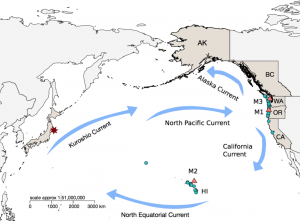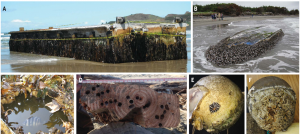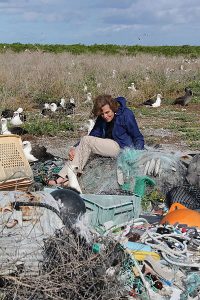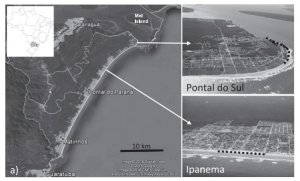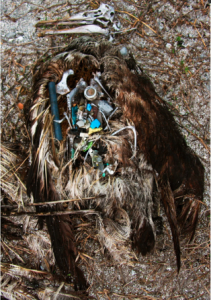Ingestion of Marine Debris and Sperm Whales
By Jessica Daley, SRC intern
Marine debris is one of the greatest threats facing marine life today. Any man-made, produced, or processed material that is either intentionally or accidentally discarded and finds its way to the ocean is considered marine debris. There are two major hazards to marine life from interactions with debris, entanglement and ingestion (Jacobsen et al. 2010). Entanglement occurs when an animal becomes trapped or wrapped in marine debris and is unable to escape. In some cases this involves discarded nets and other fishing gear, which can ensnare nearby marine life. This is especially dangerous for marine mammals, which breathe air and can drown if they are unable to free themselves (Jacobsen et al. 2010). Some entanglement cases are not lethal, but still severely damage the animal. For example, if a young turtle becomes trapped in a soda-case ring, it may not cause any problems at first. As the turtle grows, however, the ring becomes tighter and tighter on the body, warping the shell and potentially damaging internal organs.
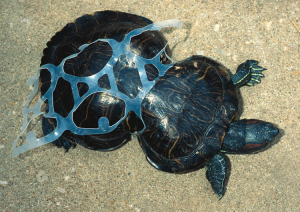
A turtle trapped in a plastic soda ring has grown around the debris, warping its shell. [Leijon, Stefan. “Plastic Turtle.” 29 July 2012. https://www.flickr.com/photos/lionsthlm/7665309574]
In the winter of 2016, a study was conducted by Unger et al. on the marine debris found inside 22 sperm whales that stranded and died along the coast of the North Sea (in England, France, the Netherlands, Germany, and Denmark). Prior to this study only 17 cases of debris ingestion had been noted in sperm whales (Unger et al. 2016). Sperm whales are deep-water animals, feeding mostly on squid at depths of more than 1000 meters, but must return to the surface to breathe (Unger et al. 2016). Because they live so deep, it is uncommon for sperm whales to strand. The North Sea is a shallow and variable habitat that is far from ideal for the sperm whale, and has a comparatively high stranding rate on its shores (Unger et al. 2016). Between January 8th and February 24th, 2016, a total of 30 sperm whales stranded along the North Sea. Of these, 22 whales had their gastro-intestinal tracts opened and examined during their necropsies. Seven GTIs were then rinsed and sieved to look for evidence of smaller debris bits. Fecal samples were also taken from 12 of the whales to look for evidence of micoplastics. The thickness of the whales’ blubber was also measured to assess nutritional status.
Nine of the 22 whales were found to have marine debris in their GI tracts, for a combined total of 322 pieces of trash. Of the debris found 78% was assorted fishing gear, including nets, hooks, monofilament fishing line, and rope. The remaining 22% was considered general debris, or anything that was not fishing related. Among the items discovered were a chocolate wrapper, a plastic bucket (broken in half), and a plastic car engine cover. It could not be determined that debris in any of the whales was the cause of death, and all of the whales were found to be in good overall nutritional health. No GI tract lesions or other internal injuries were observed either.
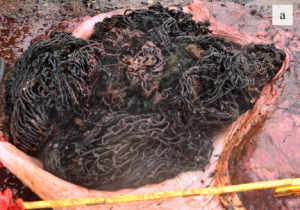
A large net inside the stomach of one of the stranded North Sea sperm whales [Ungar et al. https://www.ncbi.nlm.nih.gov/pubmed/27539635]
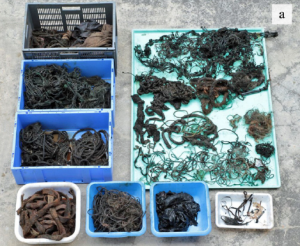
A collection of all of the debris found inside a single whale [Ungar et al. https://www.ncbi.nlm.nih.gov/pubmed/27539635]
There is a tremendous amount of evidence that demonstrates how dangerous marine debris is to sea life because of potential entanglement and ingestion. The most effective way to help protect these animals is to limit the amount of trash that enters the ocean, as well as attempting to remove what is already there. The United States alone produced 254 million tons of trash in 2013, and some of that trash inevitably ends up in the ocean (EPA). If you are interested in helping to decrease the amount of debris in the oceans there are many things you can do. Limiting your single-use plastic usage is perhaps the most impactful thing you can do, by doing things like using reusable shopping bags, using metal silverware instead of plastic, not using plastic straws, and using a reusable water bottle (Smithsonian Ocean Team). Beach clean-ups are a great way to help prevent coastal trash from making its way to the ocean. If you are a fisherman, you should avoid cutting and losing nets and monofilament lines so that do not become a potential hazard to animals (Smithsonian Ocean Team). While they may seem like small contributions, they can make a major impact on the lives of marine creatures.
Works Cited
Jacobsen, Jeff K., et al. “Fatal Ingestion of Floating Net Debris by Two Sperm Whales (Physeter Macrocephalus).” Marine Pollution Bulletin, vol. 60, no. 5, 2010, pp. 765–767.
Mascarenhas, Rita, et al. “Plastic Debris Ingestion by Sea Turtle in Paraı́ba, Brazil.” Marine Pollution Bulletin, vol. 49, no. 4, Aug. 2004, pp. 354–355.
“Municipal Solid Waste.” EPA, Environmental Protection Agency, archive.epa.gov/epawaste/nonhaz/municipal/web/html/.
Smithsonian Ocean Team. “How You Can Help the Ocean.” Ocean Portal | Smithsonian, Smithsonian’s National Museum of Natural History, 27 Dec. 2017, ocean.si.edu/ocean-news/how-you-can-help-ocean.
Unger, Bianca, et al. “Large Amounts of Marine Debris Found in Sperm Whales Stranded along the North Sea Coast in Early 2016.” Marine Pollution Bulletin, vol. 112, no. 1-2, 2016, pp. 134–141.

